List of Dog Commands and Hand Signals

Dog hand signals are an indispensable part of dog training for owners and professional trainers. Verbal cues certainly play a huge role in communicating with dogs. However, dogs' language understanding is limited compared to their ability to read nonverbal cues and body language. That is why hand gestures have become a powerful tool for effective human-canine communication.
This guide gives you valuable tips and tricks for training hand signals. In addition, we provide pictures of hand signals for dog training to give you a better idea of what the gestures should look like.
Why Should You Teach Your Dog Hand Signals?
Hand commands for dogs provide a clear and consistent means of communicating with your dog, regardless of the noise level or distractions in the environment. Thus, when walking your dog outside, you may often find yourself in a noisy area where a dog fails to hear your verbal cues. You may replace the commands with hand signals to effectively guide your dog in a desired behavior.
Hand signals can also come in handy for those who own senior dogs. Many dogs develop hearing issues as they get older. If your deaf dog is familiar with hand signals, you can alternate communication methods to improve dog obedience with hand signals.
Finally, hand signals help your dog understand you better. Just like humans, dogs get information not only from spoken words. They consider our tone of voice, body position, and gestures. That’s why pairing a hand signal with a command can make it easier to convey the message and facilitate communication between a dog and their owner.
How to Teach your Dog Hand Signals the Right Way
Teaching your furry friend how to respond to dog hand gestures is essential, and you should introduce your dog to them as soon as possible. Dogs are highly intuitive creatures and can learn to associate specific hand gestures with particular behaviors quickly. Nevertheless, success requires time, patience, and consistency.
Decide on the type of dog commands
The list of dog commands and hand signals is quite extensive. What hand signs for dogs should you teach? There are no strict sets of commands you should introduce your dog to. The choice is up to you.
Once you have chosen the signals, it's time to practice. Ensure all household members understand hand signals and stick to the gestures you originally learned.
Interesting fact: Did you know many hand signals are based on American Sign Language?
Be consistent
Dogs learn through repetition, so using the same hand commands is essential when you ask your dog to perform a behavior. For example, if you use a closed fist to signal "Sit," stick with that gesture whenever you ask your dog to sit. This consistency will help your dog learn the association between the hand signal and the desired behavior.
Link the signal with the behavior
Start using the dog hand sign before you ask your dog to perform the behavior. If you're using luring to teach a behavior to the dog, you can gradually change the luring motion to look more and more similar to the hand signal.
For example, use the "Stay" hand signal and the verbal command "Stay". Eventually, your dog will start to anticipate the command based on the hand signal alone. Once your dog consistently responds to the hand signal, you can phase out the verbal command.
Use positive reinforcement
Dogs respond best to praise and rewards, so show your furry friend plenty when they react correctly to a hand signal. You can use treats, praise, and toys to reinforce your desired behavior. Remember to keep training sessions short and fun, and always end on a positive note.
Basic list of dog commands and hand signals
Here are some of the essential dog hand signals that every dog owner should know:
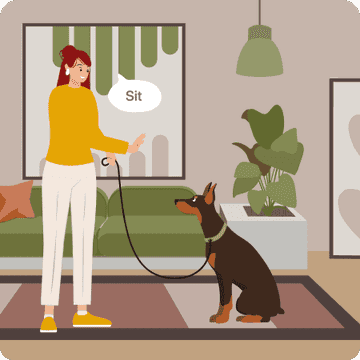
Sit
The dog hand signal for sit is among the most popular hand signals for dog training. With your palm facing up, raise your hand above your dog's head and slowly move it backward. This gesture signals your dog to sit.
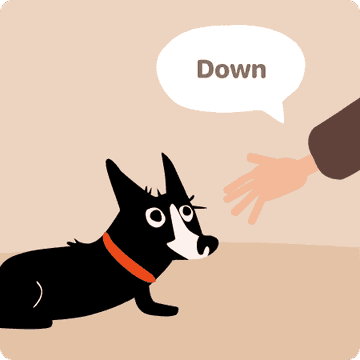
Down
With your palm facing down, sweep your hand to the ground. This signal indicates your dog should lie down.
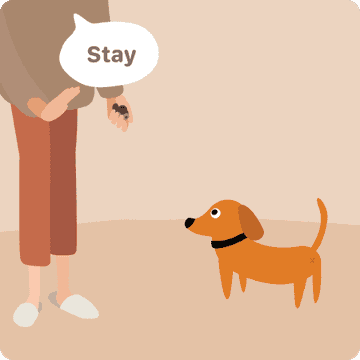
Stay
Hold your palm facing your dog, and say "Stay" while stepping back. This signal tells your dog to remain in its current position.
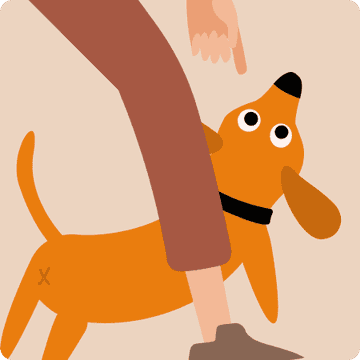
No
Hold your hand, palm facing your dog, and firmly say "No". This gesture warns your dog to stop what they're doing.
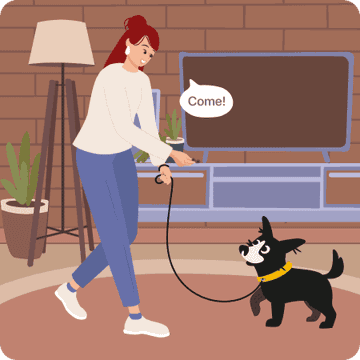
Come
Open your arms wide and say, "Come". This signal invites your dog to come to you.
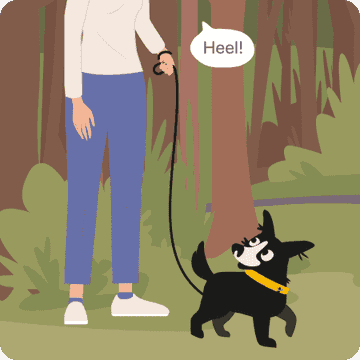
Heel
Hold your hand at your side, with your palm facing your leg. This signal prompts your dog to walk alongside you.
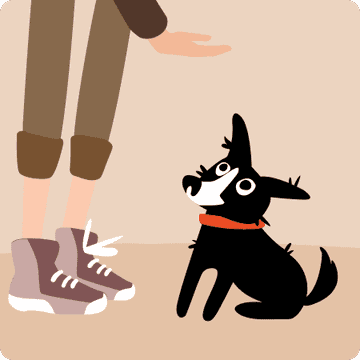
Stand
Hold your hand, palm facing your dog, and say, "Stand". This signal prompts your dog to stand on all fours.
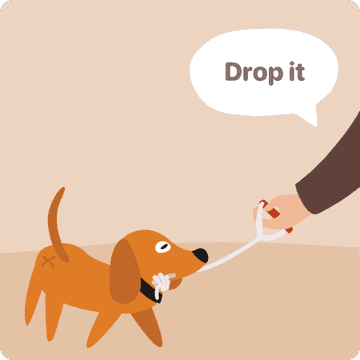
Drop it
Play with your pup so that they grab the toy with their teeth. Next, stop playing the game and say, “Drop it”. Or show them another toy or a treat, and they'll likely drop if your dog doesn’t do that within a few seconds after stopping the game.
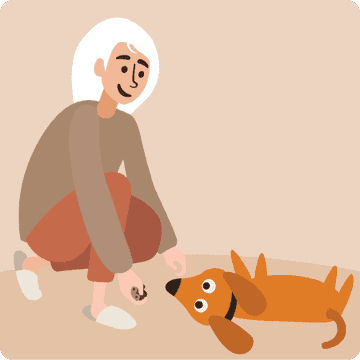
Dead
Point your finger at your dog and say "Bang" or “Boom”. This gesture prompts your dog to lie down on their side.
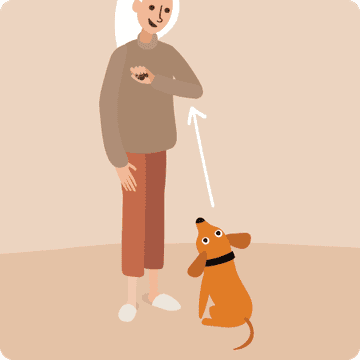
Look at me
Call your pup’s name. Once you have their undivided attention and they look at you, praise and give a treat by pulling your hand with the treat to your chest. Wait till your doggo looks at you intently. Repeat this 10-20 times daily until the achieved result.
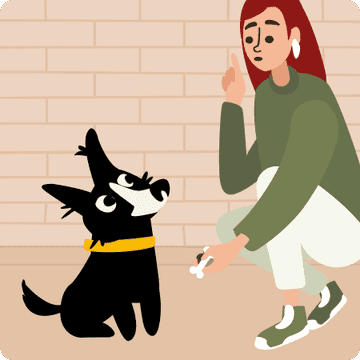
Quiet
Hold your index finger to your lips and shush your dog. This signal tells your dog to stop barking or making noise.
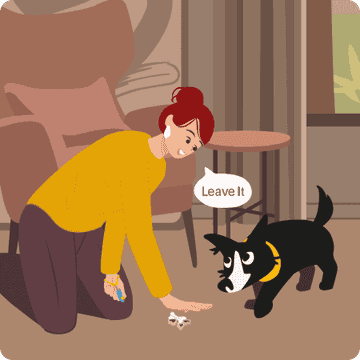
Leave it
Hold your hand, palm facing your dog, and say, "Leave it." This gesture signals your dog to leave whatever they're interested in alone.
Using these hand commands for dog training, you can communicate more effectively with your furry friend, making day-to-day interactions smoother and more enjoyable.
Hand Signal Training : How to Make Your Dog Focus on You
The key to successful dog training is to make your dog pay attention to you. Dogs are naturally interested in getting attention from us, but is it possible to encourage your dog to stay focused on you?
Though some more independent breeds can have trouble concentrating, you can help them with simple training tips.
Many owners report the positive effect of introducing their dogs to attention cues. One of the most popular ones is V-shaped fingers that point toward your eyes. Pair it with a verbal cue: “Watch me!”
Train smarter with our Hand Signals Chart! Get clear, visual guidance for effective communication!
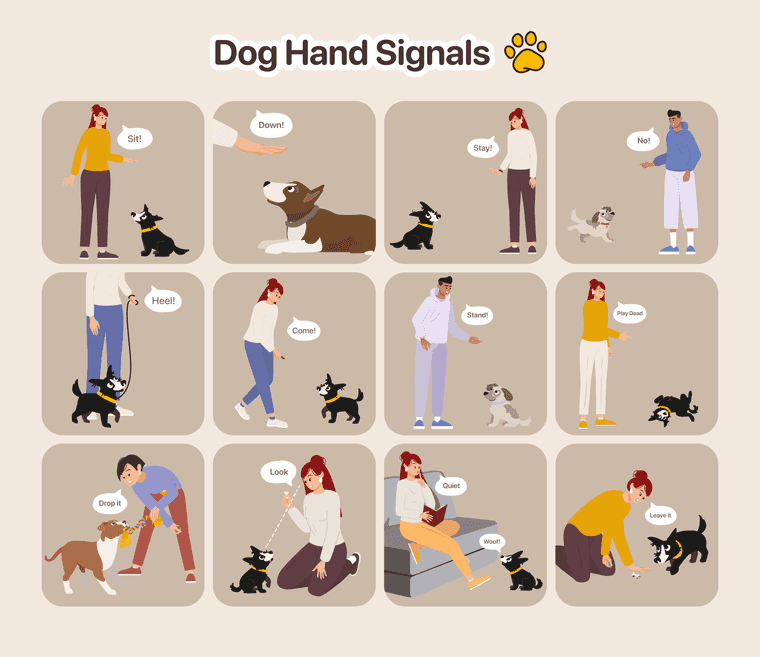
More Tips for Effective Use of Basic Hand Signals for Dogs
Use clear and consistent hand signs for dogs
Use the same dog hand signal for a particular situation and behavior each time. If you use a specific signal for a dog, avoid changing it during training. It’s also vital to inform everyone who will spend time with your dog to stick to the chosen signals. It helps prevent confusion and build stronger associations in your dog’s head.
Use appropriate timing
Your signal should come at the exact moment that you want your dog to perform a behavior. So, ensure your dog is paying attention to you in the moment. Otherwise, they might need extra clarification about what you ask them.
Give your dog time to figure it out
Some dogs need more time to make it click. If your dog struggles to grasp the idea behind a hand signal, stay patient. Go back a few steps in the training process and give your dog more time to connect the dots.
Be responsive to your dog’s body language
Dogs learn best in a relaxing and fun environment. Pressing them too much can make the dog anxious and stressed about the training. Be mindful of your dog’s body cues and check the signs of stress, fatigue or irritation to keep the training sessions entertaining.
Avoid contradictory dog training signs
Avoid confusing or contradictory signals. If you use the same hand signal for two behaviors, your dog may get confused and unsure of what you want them to do. Similarly, if you use conflicting signals, such as a hand motion for "Come," indicating playtime, your dog may not take you seriously when you want them to come to you.
Can You Teach Hand Dog Commands for Adult Dogs?
It’s easier to start puppy training with hand signals when you introduce a pup to basic obedience commands. Just like little sponges, puppies are wired to absorb information about the big world around them, including rules in the form of basic commands.
Many pet owners start using some of the hand signals intuitively. For example, pressing a finger against your lips when giving the command: “Quiet!” is what many owners do unintentionally. Basic hand signals have become an integral part of our communication systems.
However, if your dog is mature and knows some verbal commands, you can still pair them with visual signals. Start adding a hand signal right before you give a command. Practice consistently with regular intervals to achieve the best results.
That’s a Wrap
Teaching hand commands for dogs is a handy tool that smoothes communication between you and your friend. These visual cues help when verbal commands might not be heard or confuse your dog, such as in noisy environments or from a distance. Don’t hesitate to teach your pooch the commands. It's not only handy but fun!
Frequently Asked Questions

Passionate team dedicated to help pet owners raise safe and obedient dogs, fostering meaningful connections with their furry companions.

Certified dog trainer, exclusive positive reinforcement methods & tackling aggression problems.